

The Value of Frequency-Based Solutions for Robotics and Logistics Projects
To witness an industrial facility in action is a marvel. It is inspiring to consider the amount of engineering it takes to build any key industrial function. A step further, and it becomes clear that many systems are precisely and effectively operating all at once. Each element coordinates with the others for even richer data and performance.
As we outlined in our first walkthrough article, the individual and integrated processes that help a facility run efficiently rely on timing. Why? Because timing is required for key functionalities that are critical for any electronic system: automation, monitoring and control.
Keep reading to go beyond the more common systems in an industrial factory setting to learn how quartz crystal tuning forks, real time clocks and other timing solutions affect their operations.
Timing Solutions For Robotics and Logistics End Designs
Frequency is required for the automation, monitoring and control functions for these two systems: robotics and logistics. Each requires timing to successfully play its role in a high-functioning industrial environment.
Robotics: Robots that are programmed to perform repetitive tasks depend on frequency solutions, including SMD crystals, crystal tuning forks and quartz crystal oscillators, to trigger automated robotic movement. Timing also ensures certain robotic actions occur at precise times. Sensors trigger the machine to adapt based on its environment or process data to take measurements, capture video and more. All require timing to communicate the robot’s next steps, while also transmitting data for performance analysis.
Specific systems and products that require timing solutions include:
- Robots for assembly, welding, laser cutting, machining and other manufacturing processes.
- Robotic arms for high-speed tasks.
- Computer vision inspection systems.
- Robots for safe or sterile material handling, picking, sorting and packing.
- Collaborative robots, or cobots, for quality inspection and other work alongside human team members.
- Automated guided vehicles for moving inventory and materials.
- Autonomous vehicles, like robotic tractors and harvesters.
In each of these end designs, and many more, businesses depend upon the accuracy, efficiency and performance of robots, and, by extension, timing solutions. This dependence continues to grow.
Logistics: The electronics that meet an industrial business’s logistics needs are wide-ranging. Keeping track of goods; transporting them; processing orders; and monitoring, analyzing and coordinating the supply chain each require automation, monitoring and control functionality.
Much like robotics, logistics systems and machinery also rely on timing from SMD crystals, tuning forks, quartz crystal oscillators and real time clocks. Frequency sends signals for the automation of specific tasks, such as tasks performed by guided vehicles in a warehouse. Frequency signals also communicate data on vehicle location, fuel consumption and more to monitor shipping performance and effective package tracking.
These systems and products depend upon timing to ensure the successful operation of business’s logistics:
- Warehouse management systems.
- Machinery and tools for safely handling goods.
- Warehouse robotics for packing, sorting and selecting goods.
- GPS tracking for vehicles and packages.
- Transportation management systems.
- Autonomous vehicles and drones for package transport.
- Sensors that monitor warehouse environmental conditions.
The logistics landscape depends upon timing for efficient coordination, speed and accuracy to ensure global trade occurs at the rapid pace we expect today. As a result, businesses and their consumers experience reduced costs and successful outcomes. As businesses depend more and more on technology to accelerate these outcomes and out-maneuver the supply chain challenges of the past, frequency control solutions will continue to be in high demand.
Depend On Timing Solutions For Every Industrial End Design
Crystal tuning forks, quartz crystal oscillators, SMD crystals and real time clocks provide the synchronization, orchestration and communication that the robotics and logistics facets of the industrial industry rely on.
Much like other processes, such as building automation, robotics and logistics, are a part of a facility’s daily operations. Therefore, the timing solutions that engineers in the design community select should offer the following characteristics to ensure that routine, yet critical functions succeed:
- Shock and vibration resistance
- Extended temperature range
- Exceptional stability and precision
- A low aging rate
- Long-term reliability
All verticals within the industrial market, including the energy sector, agriculture, manufacturing, warehousing and renewable energy require automation, monitoring and control to maximize production levels and meet ever-increasing measurements of success. Timing solutions bring businesses in these market segments one step closer to their goals.
Factory Walkthrough Part 2: A Further Look at Industrial Designs That Require Timing Solutions was last modified: June 17th, 2024 by